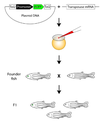Transgenic Applications I Flashcards
(55 cards)
Describe forward genetics.
This is the classical approach. Begins with a mutant phenotype and identifies the gene and mutations responsible.
Describe reverse genetics and how these studies are possible.
Begin with a known gene and make mutations to it using recombinant DNA technology in order to analyze its phenotype/gene function.
How is random mutagenesis performed, and what model organisms are used?
- Damage of DNA by chemicals or raditation
- Typically use bacteria, yeast, worms, and fruit flies
Define a transgene.
An altered gene taken from one organism or genome and transferred to another (i.e. any foreign or modified genes that are added)
Define a transgeneic organism.
Any organism that has stably incorporated one or more genes from another cell or organism and can pass the gene to successive organisms
Describe the transgene construct design.
- Need an enhancer/promotor: can be endogenous, foreign, inducible, or cell specific
- Need the gene of interest: can be gDNA (genomic DNA) or cDNA (just exons)
- Can use a selectable marker: positive or negative
How is the gene of interest for transgenic studies acquired?
By screening a library to obtain the gDNA or cDNA
Cloning vs subcloning?
Cloning is the procedure which produces genetically identical organisms or cells.Subcloning is a procedure of moving a gene of interest from one vector to another vector to see the expression of the gene to gain the desired functionality of the gene.
What considerations need to be made prior to subcloning DNA into a model organism?
- Can the organism handle the manipulation required to add the transgenic contruct?
- How will the cell process the DNA introduced?
- How will the specific cells treated contribute to all tissues in a developing organism?
- WIll DNA be inserted randomly (could disrupt other gene expression) or homologously (targeted)?
Describe transfection.
Introduction of a foregin DNA molecule, such as a plasmid, into a eukaryotic cell, followed by expression of the genes in the newly introduced DNA.
Describe transfection by direct injection.
Uses tiny needle to directly inject DNA into the nucleus of the cell.
Describe transfection by electroporation.
The cell is put in an electric field in order to make the membrane transiently permeable.
Describe liposome-mediated transfection.
Uses lipids that aggregate with DNA to incorporate with and pass through the membrane. Efficient, easy, and low in toxicity.
Describe transfection by DEAE/Dextran.
Simple, fast, cheap, but cytotoxic. Positively charge DEAE/Dextran aggregates with negatively charged DNA to get it into the cell.
Describe transfection by calcium phosphate.
Aggregates with the DNA and allows it to bind the cell surface.
Describe transfection by particle bombardment (gene gun).
Gold or tungsten beads with DNA bound to them are directly shot into the cell.
Describe phenotypic vs genotypic screening for a successful transfection.
- Phenotypic: observe expression of a selectable marker, negative or positive.
- PCR of the DNA, southern, northern for mRNA expression, and western for protein expression.
What is the biggest consideration when deciding what vector to use for transfection?
The type of model organism being used.
What makes Arabadopsis a good model organism?
- small genome
- totipotent, meaning a single cell can give rise to the entire organism
(tobacco is also a good plant model organism!)
What types of vegetables are transformed by A. tumefaciens chromosomes, and what do they have in common?
soybeans, squash tomatoes. They all have the naturally-ocurring TI plasmid. These are dicodeledons, like Arabidopsis thaliana and tobacco.
Describe the TI plasmid in A. tumefaciens in general and how its DNA enters a dicodeledon.
A. tumefaciens is a soik-dwelling bacteria that has a Ti-plasmid containing T DNA. The T DNA enters the A. tumefaciens chromosome and the chromosome is transformed into the plant cell at areas of damage. The transformation causes the formation of a crown gall tumor at this site of damage.
Describe the Ti-plasmid and T-DNA in detail.
It is a binary system because the T-DNA is a vector within the Ti-plasmid.
- the Ti-plasmid codes vir genes that cut T-DNA at its right and left boundaries. Right border of Ti-plasmid is inactivated until plant cell transformation so that vir does not cut out tet marker of T-DNA before transformation into plant cells.
- T-DNA has the transgene and anti-kanomycin plant selectable marker on one side of the right and left boundaries, and the tetracycline bacteria selectable marker on the other side
- T-DNA transformed into A. tumefaciens that already has Ti-plasmid by electroporation and screened for using tetracycline.
- wounded plant cell then exposed to agro bacteria and vir is expressed and cuts out tet selectable marker and right and left boundaries of T-DNA
- can select for transformation in plant cell using kanomycin
Why is particle bombardment (gene gun) sometimes used to generate transgenic plants rather than with the Ti-plasmid?
Some plants are resistant to the Ti-DNA transformation process due to different wound responses, so the whole plant is subject to gene gun.
Describe the constitutive and inducible promotors used in some transgenic plant targeting vectors.
- contitutive: cauliflower mosaic virus 35S RNA
- inducible: heat shock, copper ions, antibiotics




